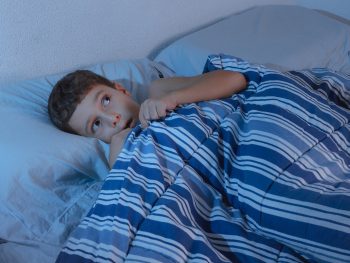For parents raising their first child, their first experience of a kid undergoing a night terror episode can be quite overwhelming.
In occurrences that are eerily similar to a Hollywood portrayal of demon possession, children suffering night terrors can trash around, open their eyes, sit up, let out scary howls and shrieks, yet wake up with absolutely no recollection of the event.
However, night terror episodes are not limited to children alone. While night terrors mainly affect children, with nearly 40% of kids reporting at least an incident, according to an article in PubMed Central, up to 2% of adults experience this parasomnia. Plus, the figure may be severely underreported, as since people wake up with no memory of experiencing night terrors, if you sleep alone, you may never know.
For parents with minimal experience of this phenomenon, watching an episode happen can quickly raise concerns or even result in a full-blown panic. It also doesn’t help that, in some sleepers, this episode may repeat itself multiple times in the course of one night.
Hence, to quell your worries, the report details what night terror is, some potential triggers, and when there is a valid cause for concern.
What’s a Night Terror
Night terrors are a form of sleep disruption that is akin to nightmares but are often significantly more dramatic.
These sleep terror occurrences can vary from person to person, incorporating elements such as thrashing around, screaming, intense fear and panic, sleepwalking, and having the eyes open, all while the sufferer is still asleep and entirely unconscious.
Night terror episodes often begin with some moaning, twitching, and limb movement that quickly escalates to full-on wild thrashing and screaming. Amidst this spell, the sleeper may stare at or right through partners or parents, or even bring them into some obscure, outlandish, and scary fantasy plotline. In rare occurrences, the sleeper may also inflict harm on others.
Note: Night terrors (known medically as pavor nocturnus) can last anywhere from 1 to 20 minutes. However, an episode may repeat several times throughout the night.
To further compound the issue, sleepers undergoing a night terror episode are notorious for being hard to arouse, even though they may already appear awake. Plus, when you do get them up, especially with children, comforting someone who just had a night terror incident can be hard.
The one saving grace is that sleep terror episodes typically last for a few minutes or less. However, in rare cases, some cases can drag for more extended periods.
Sleep terror episodes typically happen closer to bedtime than wake time, with most incidents occurring in the first third of the night. Furthermore, one demographic that posts a significant percentage of all night terror occurrences are overworked children or those with significant emotional or physical upheavals.
Note: If you can, avoid waking a sleeper from a night terror episode, especially with kids. Waking them up will most likely leave them disoriented, and it may take a protracted time for them to relax and go back to sleep, which may give rise to symptoms of sleep deprivation during wake time.
However, while night terrors may be scary events for parents or spouses, they are typically not a cause for any medical concern.
Read More: What’s a Night Terror?
Night Terror Symptoms
Traits that define sleep terror episodes include:
No Memory: One of the most common signs that a sleeper had a night terror episode rather than a nightmare, is that they have absolutely no recollection of the occurrence.
Stays Sleeping: Another indicator is that, with sleep terrors, the sleeper often continues sleeping as soon as the episode ends without breaching unconsciousness.
Timing: Sleep terrors tend to occur in the first third of the typical sleep cycle. Hence, most night terror episodes will happen before midnight. However, sleep terror occurring during naps is extremely rare.
Other signs that a sleeper may be experiencing a night terror episode include:
- Letting a frightened scream out of the blue
- Staring wide-eyed
- Sitting up at alert
- Kicking and thrashing continuously
- sweating, a racing pulse, breathing heavily, dilated pupils, and other signs of extreme fright
- Sleepwalking and possibly aggressive behavior
- Being hard to awaken or console
- Waking up in a confused, inconsolable state
When to Consider Seeing a Doctor?
Sleep terrors are rarely ever a cause for concern, especially so in children. Most children will grow out of it by adulthood, and even in adults, since night terrors often stem from problematic sleep, you can fix most cases by improving your sleep hygiene.
However, in some extreme cases, you should consider visiting the doctor for a more extensive examination. Some potential scenarios include:
- An alarmingly increasing frequency of night terror episodes
- Intense episodes that cause injury or other safety concerns
- Severe disruption of daytime activities due to sleep deprivation or reduced cognition
- Night terrors onset and persistence in adulthood without any prior occurrences in childhood
Read More: How to Stop Night Terrors: 12 Proven Mind Tricks
Other Frequently Asked Questions
Q: Are Night Terrors and Nightmares the Same Thing?
No. Nightmares are distressing dreams that leave you recalling bits and pieces when you wake up. On the other hand, with night terrors, you get more vigorous, terrifying episodes accompanied by intense screaming, fear, and body movement, with no recollection of the event when you eventually wake.
Q: What Causes Night Terrors?
Similar to dreams and nightmares, night terrors stem from an over-arousal of the central nervous system during sleep. When this arousal happens during REM sleep, you often get dreams—including nightmares. In the non-REM stages, however, nervous excitement may trigger sleep terror episodes.
More: What Causes Night Terrors in Children?
Q: At What Age do Night Terrors Start?
The most common age-group that gets sleep terrors is around the 3-4 years mark. However, smaller children, from around 18 months, can have episodes too, though they are quite rare. However, the chance of occurrence reduces drastically with even younger infants.
Q: At What Age do Night Terrors End?
For most children, they should stop getting sleep terror episodes by age 12. If the events persist long into adulthood, you should consider visiting a health care practitioner for a checkup.





Leave a Reply